Chris Ware’s ‘New Yorker’ Covers Are Perfect
Ware’s animation is in a league of its own; incisive, amusing, direct and deeply layered.

Chris Ware, the wonderful artist responsible for the labyrinthine graphic novel Jimmy Corrigan, the Smartest Kid on Earth and the ambitious comic box-set Building Stories, has provided The New Yorker with a number of indelible covers over the years.
Each one views life in America with, alternately, sad-eyed defeatism and bittersweet triumph. Yet, those of us outside of the United States can still take much from them, rendering as they do our sometimes exasperating, sometimes inspiring modern-day existence. Also: they’re pretty.
His latest — hitting newsstands (if that’s even a thing these days) this week — is no different. Titled ‘Protocol’, it depicts two kids innocently reaching out to touch hands as their parents give each other the ol’ side-eye in a shopping center vaccination clinic.
It captures in amber the fear and scepticism permeating waiting rooms across America right now: of Ebola, most recently, but also of flu shots (courtesy of Dr. Jenny McCarthy), healthcare insurance, and, most persistently, one another.
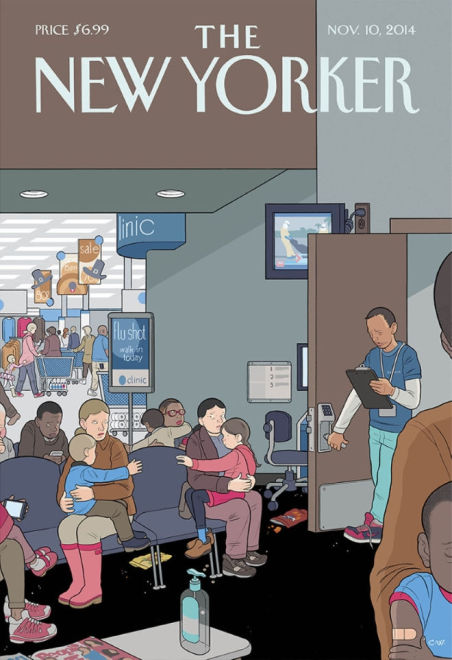
Note the TV screen, featuring doctors in Hazmat suits disposing of a body. In the background though, the hum of Thanksgiving shopping carries on as per usual, because nothing can stop that commerce train. Directly in the foreground? A bottle of Purell. Yeah, that’ll help.
Here’s how Ware, with typical offbeat humour, described the inspiration behind his image: “As a kid who read a lot of science fiction, I’m not sure what I thought American health care would be by the time I became an adult, but I certainly didn’t expect it to involve shelves of Extreme Doritos, buckets of off-brand Cheez Doodles, bottles of Hennessey capped with black-plastic theft hats, and wire bins of hot-pink Koosh balls.”
The New Yorker has a reputation for dry-as-death “witty” cartoons that aren’t actually all that funny. As Elaine ingeniously told its editor: “You doodle a couple of bears at a cocktail party talking about the stock market, you think you’re doing comedy!”
However, Ware’s animation is in a league of its own; incisive, amusing, direct and deeply layered. To celebrate the publication of ‘Protocol’, let’s travel back through the archives and look at his best contributions.
–
‘All Together Now‘: January 2014
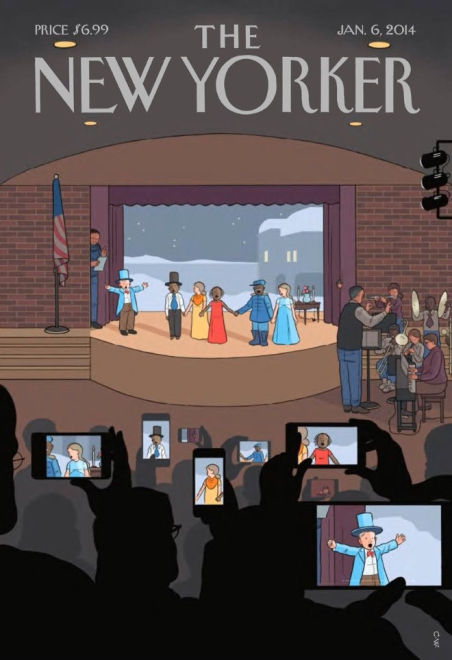
Earlier this year, Ware astutely satirised the isolating effect of iPhone culture in adorable fashion. As he described: “Steve Jobs, along with whatever else we’re crediting to him, should be granted the patent on converting the universal human gesture for trying to remember something from looking above one’s head to fumbling in one’s pants pocket.”
‘All Together Now’ doesn’t herald the end of days, or the death of human connection. It’s just poking a little fun at us. And despite it being easy to read this image as a judgmental look at our smartphone obsession, Ware offers another explanation: “I heard one of the Newtown families interviewed on the radio — they’d lost their only daughter that day — … and all they had left of her were their memories, and their pictures.”
–
‘Threshold‘: January 2013
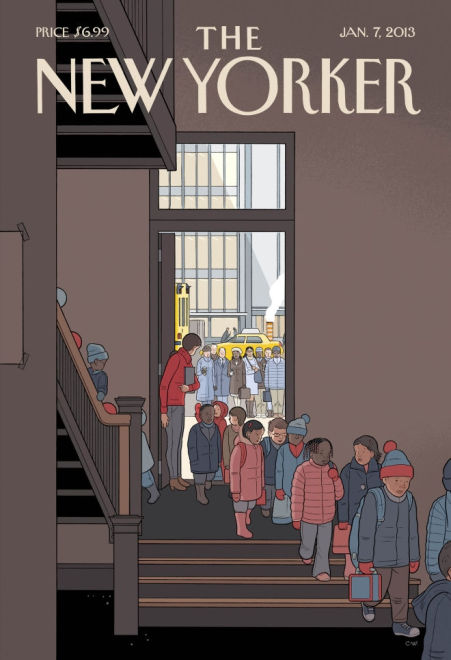
‘All Together Now’, the first New Yorker cover of 2014, is a slightly chirpier sequel to 2013’s first cover (also by Ware): ‘Threshold’, released in the wake of the Newtown shooting. It shows kids entering the supposed-to-be-safe confines of a school, their mums and dads nervously watching from the outside. Himself a parent, it was a tribute to the teachers who do the thankless work of preparing his children for the often-awful outside world, and the torture of having to hand your kids over to a country that’s seemingly unwilling to protect them.
“My wife is a public-high-school teacher in Chicago, and though there has never been a shooting in her school during her tenure, there have been fights and thefts… Needless to say, rarely does a day pass where I don’t pray to my vague, atheist-default Supreme Ruler of the Universe that everything go effing well for her,” Ware says. You can see that secular prayer being silently whispered by the parents hovering beyond this school’s threshold.
–
‘Back to School‘: September 2012
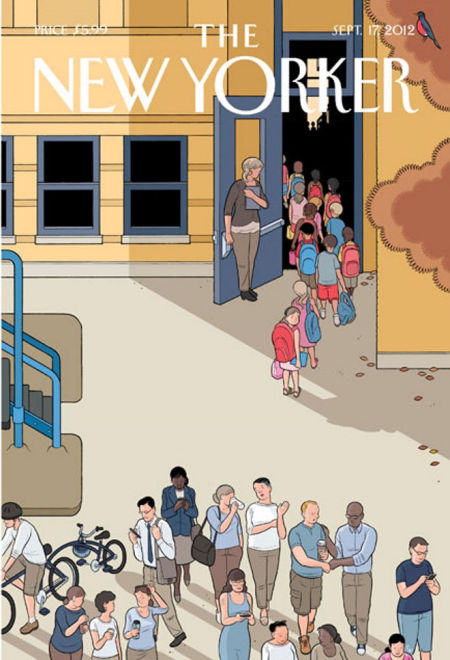
Not many months earlier than the release of ‘Threshold’, Ware had brilliantly imagined the more innocent flipside: melancholy kids heading back to school at the conclusion of summer; one looking back on all the parents relieved to be returning to their own lives. Some are tinkering with their phones; others are having a gasbag; some are sipping coffee; one dude is jetting off solo on his tandem bicycle; I even spotted a fist-bump.
A few months later, in the cold light of the Sandy Hook shootings, Ware explained his original inspiration: “It was something I saw every morning, and I thought it would make a sort of funny picture. In the wake of Newtown, it didn’t seem so funny anymore.”
Seeing ‘Threshold’ and ‘Back to School’ side by side is an undeniably powerful viewing experience. Still, here’s hoping ‘Back to School’ one day seems as funny as it was once intended, when school shootings are a distant, horrible memory.
–
‘Happy Mother’s Day‘: May 2013
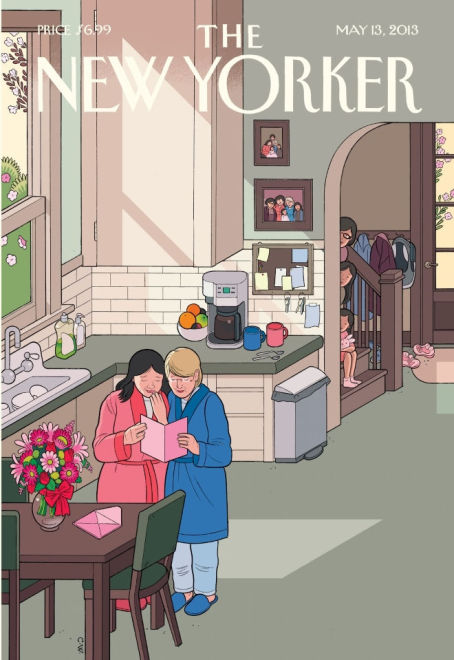
The Sandy Hook shootings must have underlined in Ware the inherent guilt and fear of parenthood. He’d reclaim the beauty of it all with this paean to same-sex marriage in 2013. Its message is crystal clear: two mothers reading from the same touching Mother’s Day card, their kids spying them from the staircase; a familiar, idyllic vision of a family. It’s a political image precisely because it’s banal; so sweet that not even right-wing stalwarts could consider it evil.
Here’s how Ware envisioned it: “In the spirit of openheartedness and what life is really all about, I’ll go so far as to say that the [Republicans’] fear of others may mask some deep-seated desire to understand, and maybe even to love. Because really, what is there to be afraid of? That same-sex marriage could go from its preliminary draft of ‘diagnosable’ to the final edit of ‘so what?’ must indicate some positive evolution on the part of the larger human consciousness.”
The sentiment of “so what?”, as illustrated here, has never been quite so significant.
–
As each issue reminds you, The New Yorker costs just US$6.99, or US$120 (plus shipping) for a year’s worth. What’s within the issue is almost irrelevant; if Ware is on the cover, $6.99 for a printing of his artwork is a steal.
–
Simon Miraudo is an AFCA award-winning writer and film critic. He is also co-host of The Podcasting Couch and tweets at @simonmiraudo.